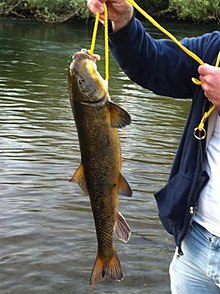Largescale sucker
This article needs more links to other articles to help integrate it into the encyclopedia. (August 2018) |
| Largescale sucker | |
|---|---|

| |
| Scientific classification | |
| Domain: | Eukaryota |
| Kingdom: | Animalia |
| Phylum: | Chordata |
| Class: | Actinopterygii |
| Order: | Cypriniformes |
| Family: | Catostomidae |
| Genus: | Catostomus |
| Species: | Catostomus macrocheilus
|
| Binomial name | |
| Catostomus macrocheilus Girard, 1856
| |

The largescale sucker (Catostomus macrocheilus) is a species of sucker found in western North America.
The largescale sucker is native to the Pacific Northwest, occurring from British Columbia south to Oregon. It is widespread in the Columbia River system. It occurs in the slower-moving portions of rivers and streams, and in lakes.
Largescale suckers spawn in the spring in shallow water over sandy areas of streams or the sandy or small gravel shoals of lakes. Females may produce up to 20,000 adhesive eggs. The young feed upon small zooplankton until they become bottom dwellers. Then they feed on benthic aquatic invertebrates, diatoms, and other plant material.
This species reaches a length of 24 inches and 7 pounds in parts of their range.[1]
They are an important part of the food web and the diet of fish-eating animals (such as osprey, eagles, river otters, and other fish).[2]
Characteristics
Color Juvenile: mottled brown or olive green with dark spots and white to yellow belly.
Color Adult: bronze to orange on top with lighter undersides.
Description: Rounded snout with downturned mouth on its underside (1) (as opposed to a mouth at end of head like most fish). Large scales and narrow tail base (caudal peduncle).
Size: Juvenile < 4" Adult < 24"
References
- ^ "Fishes of Idaho - Idaho Chapter of the American Fisheries Society". Iahoafs.org. Retrieved 6 July 2018.
- ^ "Field Guide to Common Fish of the Willamette Valley Floodplain" (PDF). Ir.library.oregonstate.edu. Retrieved 6 July 2018.
- Froese, Rainer; Pauly, Daniel (eds.) (2011). "Catostomus macrocheilus" in FishBase. August 2011 version.
